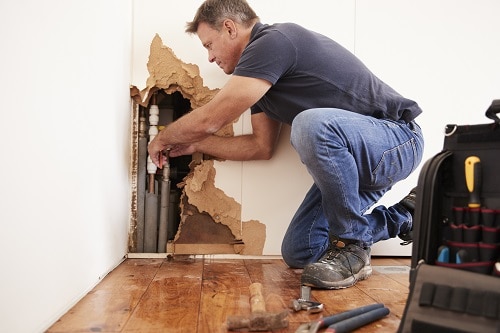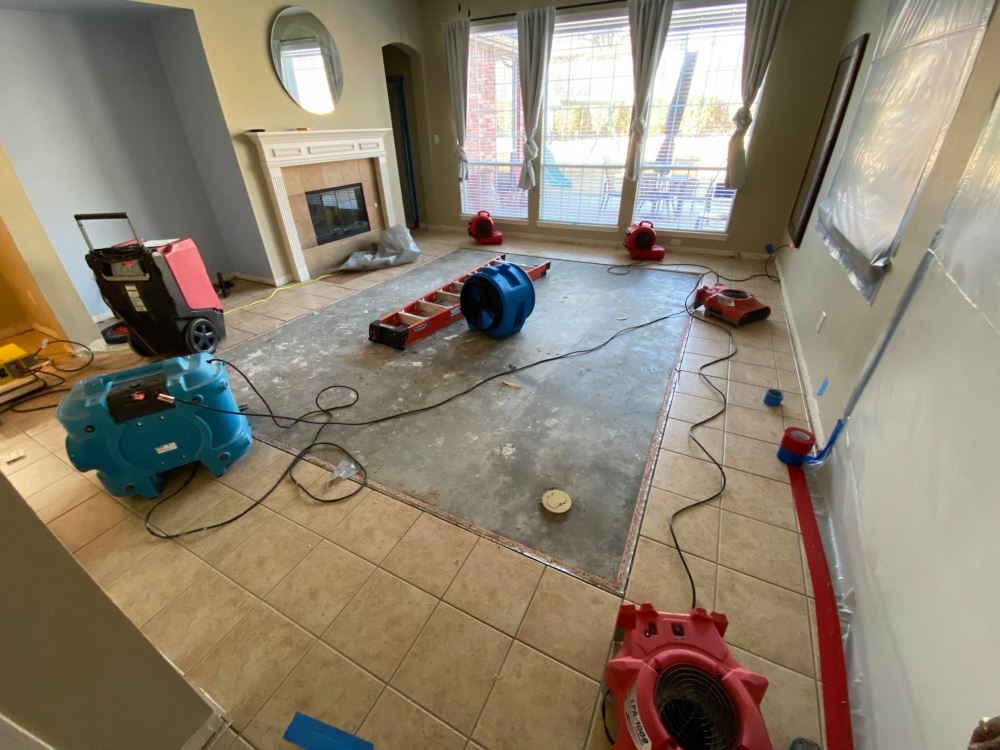Top Tips for Effective Water Damage Restoration: Protect Your Property Today
Water damage can strike unexpectedly, triggering substantial interruption and possible threats. Reliable restoration requires a methodical approach to decrease further damage. From assessing the damage to carrying out safety nets, each step plays a vital function in safeguarding residential property. Understanding these techniques can make all the distinction in the results of a water-related dilemma. What important activities should be prioritized to guarantee complete protection?
Evaluate the Damage Immediately

Shut down the Supply Of Water
Shutting down the water system is an important action in preventing further damage throughout a water-related occurrence. When a leak or flooding happens, prompt action is important to minimize the extent of the damage. Situating the primary water shut-off valve should be a concern. This shutoff is usually located near the water meter or where the water line enters the property. As soon as situated, transforming the shutoff clockwise will certainly stop the flow of water. In cases where the major shutoff is inaccessible, private shut-off valves for devices may likewise be used. Immediately turning off the supply of water not just safeguards the residential or commercial property from additional injury but likewise promotes the succeeding restoration process, guaranteeing that recovery efforts can begin right away.
Eliminate Excess Water Quickly
Removing excess water immediately is important for minimizing damage and stopping mold and mildew growth in influenced areas. The longer water remains in call with materials such as drywall, insulation, and wood, the higher the danger of structural damage and the advancement of mold. House owners need to act promptly to assess the circumstance and make use of appropriate tools, such as damp vacuum cleaners or pumps, to draw out standing water effectively. If the quantity of water is substantial, getting in touch with specialist restoration solutions may be essential, as they can offer specific tools and experience. In addition, eliminating furniture and belongings from the affected area can aid to reduce damage and assist in the overall restoration procedure. Prompt action not just safeguards home but also aids in a smoother recuperation trip.
Dry Out the Affected Location
After removing excess water, it is vital to dry out the afflicted area thoroughly. This entails eliminating any standing water and improving air blood circulation to facilitate dissipation. Efficient drying out will help prevent mold and mildew development and more damage.
Remove Standing Water
Promptly dealing with standing water is vital for efficient water damage restoration. The existence of stationary water can lead to more property damage and create an atmosphere for mold development. To alleviate these risks, it is essential to remove standing water as promptly as possible (Flood Cleanup Services). This process usually involves using completely submersible pumps, wet vacuum cleaners, or specialized removal equipment. Experts suggest evaluating the deepness and degree of the water before making a decision on the ideal technique for elimination. Security preventative measures need to additionally be taken, consisting of putting on protective gear and making sure electrical energy is turned off in affected areas. Once the standing water is properly eliminated, the drying out procedure can begin, further protecting the residential property from continuous damage
Boost Air Flow

Check for Mold Growth
Mold and mildew growth is a serious worry complying with water damage, as it can lead to wellness concerns and architectural wear and tear. After any kind of flooding or leaks, it is necessary to carry out a comprehensive evaluation of the influenced locations. This consists of checking surprise rooms such as behind walls, under carpets, and in attic rooms or basements where moisture might linger. Signs of mold include a stuffy odor, discoloration on surfaces, or noticeable development. Homeowner ought to utilize protective equipment when checking, as mold and mildew see page spores can pose health dangers. Flood Cleanup Services. If mold and mildew is identified, it is important to resolve it promptly, as delaying removal can worsen the issue and boost the danger of serious health and wellness issues for occupants. Early treatment is vital to effective mold management
Repair and Bring Back Damaged Structures
When resolving water damage, it is vital to initial evaluate the architectural honesty of the impacted areas (Water Damage Restoration). This assessment aids identify prospective risks and informs the required repair techniques. Engaging professional restoration solutions guarantees that the restoration process is conducted securely and properly
Examine Structural Stability First
Before initiating any water damage restoration, it is vital to evaluate the architectural honesty of the affected area. This evaluation helps determine any compromised elements, such as beams, structures, or wall surfaces, which might posture security risks. Evaluating for indications of warping, cracking, or mold growth is critical, as these signs can disclose underlying damage that needs prompt attention. Furthermore, comprehending the level of the damage can lead restoration initiatives and determine whether repair work are practical or if replacement is needed. It is essential to document findings extensively, as this details can be valuable for insurance coverage cases or future referral. Prioritizing structural analysis guarantees that restoration initiatives proceed safely and effectively, eventually shielding the building and its occupants.

Use Specialist Restoration Services
Utilizing specialist restoration solutions is crucial for successfully fixing and restoring damaged frameworks after water incidents. These professionals have the necessary training, tools, and experience to evaluate and mitigate water damage thoroughly. They can determine hidden concerns, such as mold growth and structural weaknesses, that might not be promptly obvious. Professional services also utilize innovative drying out methods and tools, ensuring that all moisture is eliminated to prevent more damage. In addition, they comply with market standards and guidelines, making certain that the restoration procedure is efficient and secure. By engaging restoration experts, homeowner can expedite healing, reduce long-term damage, and inevitably shield their financial investment - Flood Cleanup Services. This positive method is necessary in maintaining the integrity and security of afflicted structures
Protect Against Future Water Damage
To successfully prevent future water damage, homeowners need to take on a positive approach to upkeep and repair services. Regular assessment of downspouts, roofings, and rain gutters is necessary; blocked rain gutters can lead to water overflow and roofing system leaks. In addition, checking for leaks in plumbing components and devices can combat potential damage. House owners ought to additionally take into consideration installing sump pumps in basements or low-lying locations to manage water buildup. Sealing splits in structures and making sure correct drain around the residential property are essential actions in protecting against water intrusion. Additionally, maintaining moisture levels with dehumidifiers can avoid mold development. By implementing these preventative actions, homeowners can significantly minimize the risk of water damage and protect their residential or commercial property for the long-term.
When a water damage event occurs, it is crucial to assess the damage quickly to reduce more problems. Eliminating excess water without delay is crucial for lessening damage and stopping mold and mildew growth in impacted areas. Swiftly dealing with standing water is critical for effective water damage restoration. The presence of stationary water can lead to more home damage and develop an atmosphere favorable to mold and mildew development. Prior to initiating any kind of water damage restoration, it is crucial to assess the structural integrity of the damaged location.